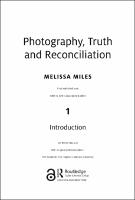Chapter Introduction
Proposal review
| dc.contributor.author | Miles, Melissa | |
| dc.date.accessioned | 2022-06-28T08:14:37Z | |
| dc.date.available | 2022-06-28T08:14:37Z | |
| dc.date.issued | 2020 | |
| dc.identifier.uri | https://library.oapen.org/handle/20.500.12657/57125 | |
| dc.description.abstract | Photography, Truth and Reconciliation examines the special place of photographs in contexts of truth and reconciliation. The moral and political implications of viewing photographs of human suffering, especially from a political and geographic distance, informs much of this body of work. The importance of acknowledging these contextual specificities is why Photography, Truth and Reconciliation is structured around five discrete national case studies: Argentina, South Africa, Canada, Australia and Cambodia. Photography’s ability to lend itself to different forms of truth means that this medium has been eagerly adopted in contexts of truth and reconciliation. Reconciliation and its relationships to photography, truth and history are similarly variable and contextually determined. In studies of transitional justice, there is little consensus about what reconciliation means and how it can be achieved. The chapter also presents an overview on the key concepts discussed in this book. | en_US |
| dc.language | English | en_US |
| dc.subject.other | history of photography, art history, visual studies | en_US |
| dc.title | Chapter Introduction | en_US |
| dc.type | chapter | |
| oapen.identifier.doi | 10.4324/9781003103820-1 | en_US |
| oapen.relation.isPublishedBy | 7b3c7b10-5b1e-40b3-860e-c6dd5197f0bb | en_US |
| oapen.relation.isPartOfBook | bdbf6e49-294c-4b01-b537-350097b64f83 | en_US |
| oapen.relation.isFundedBy | fba673a1-ae6a-4dd4-91dd-32bdd6d35a1e | en_US |
| oapen.relation.isbn | 9781032220239 | en_US |
| oapen.relation.isbn | 9781474296069 | en_US |
| oapen.imprint | Routledge | en_US |
| oapen.pages | 19 | en_US |
| peerreview.anonymity | Single-anonymised | |
| peerreview.id | bc80075c-96cc-4740-a9f3-a234bc2598f1 | |
| peerreview.open.review | No | |
| peerreview.publish.responsibility | Publisher | |
| peerreview.review.stage | Pre-publication | |
| peerreview.review.type | Proposal | |
| peerreview.reviewer.type | Internal editor | |
| peerreview.reviewer.type | External peer reviewer | |
| peerreview.title | Proposal review | |
| oapen.review.comments | Taylor & Francis open access titles are reviewed as a minimum at proposal stage by at least two external peer reviewers and an internal editor (additional reviews may be sought and additional content reviewed as required). |

